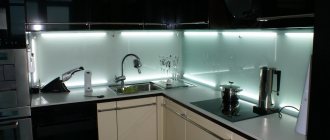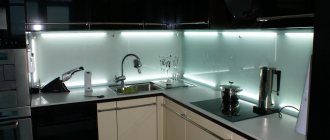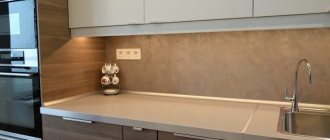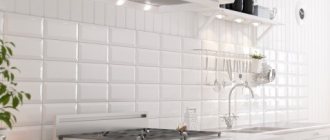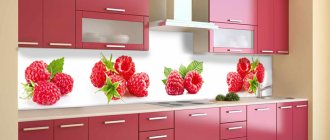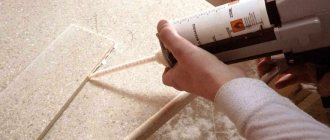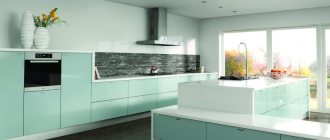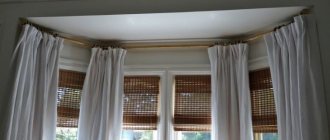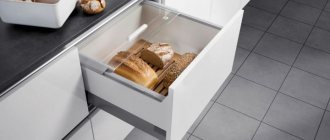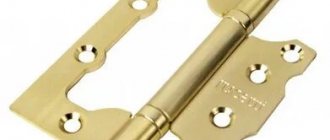/Repair/Apron/
A glass apron is a 99% ideal choice and an excellent alternative to tiles, porcelain stoneware, stone and other types of wall panels for the kitchen. If you are thinking about buying this particular type of apron, then, most likely, you have already heard that there are many varieties of kitchen aprons made of glass on the market: skinali, triplex, plexiglass, optiwhite, satin, enamel... Let's find out what these words mean and what else you need to know before going to the store.
Advantages and disadvantages
Glass aprons have become a fashionable interior detail due to the following consumer qualities:
- Strength. Glass panels are resistant to damage as they are made of tempered glass.
- Wear resistance and, as a result, long service life. The glass of the apron has increased resistance to high temperatures and mechanical loads (accidental impacts).
- Easy to care for. The apron has no seams between the tiles. Dirt is removed with water and standard detergents.
- Hygiene. The smooth, non-porous glass surface is unable to absorb water and grease, and therefore does not create an environment for the development of bacteria.
- Design possibilities. A glass apron reflects light and visually enlarges the space. It is possible to choose a finish of any color; color rendering is always impeccable.
There are no seams between the tiles Source ideasonthemove.com
People make a choice in favor of a kitchen apron, being aware of its shortcomings:
- Price. A product made of high-quality tempered glass always costs more than plastic or ceramics. But plastic can be deformed from strong heat, and the seams in a ceramic apron can become a breeding ground for mold.
- Difficult to install. Sometimes delivery and installation are complicated by the design of the corner kitchen skin. This apron must be installed by a specialist.
- Limitations of care. Glass kitchen aprons should not be cleaned with abrasives. The abrasive will not damage the pattern under the surface, but will reduce the transparency of the glass.
Reliable and beautiful Source seoceros.com
Polycarbonate apron
Polycarbonate is very similar to plexiglass, but has qualities more suitable for the role of a kitchen apron.
Pros: a glass panel for a kitchen made of polycarbonate will be much cheaper than panels made of stalinite, triplex, tiles and other popular materials. More resistant to elevated temperatures than plexiglass and stronger than tempered glass. In addition, it is lightweight, flexible, and you can install it yourself.
Cons: the main drawback is that it scratches quickly and is inferior to ordinary glass in appearance.
Which glass is suitable for an apron?
The kitchen work area is subject to significant (and sometimes unexpected) loads, so for reasons of durability and safety, tempered glass (Stalinite) is preferred. It is recommended to install an apron made of heat-resistant stalinite (7-10 times stronger than ordinary glass) near the stove.
A very strong blow can break tempered glass. At the same time, it will break into small fragments with blunt edges that are not capable of causing serious problems. Understanding the importance of the question of what kind of glass a kitchen apron is made from, most companies use glass 6-8 mm thick. There are other types of glass for kitchen skins:
- Triplex. The material consists of two layers of silicate or tempered glass, bonded with a polymer film. Thanks to this layer, upon impact, the apron does not break into fragments, but becomes covered with cracks. At the request of the customer, the film is made transparent or decorative (with a pattern). In the kitchen, triplex skins are not often found due to the high cost of the material and the complexity of installation (difficulties with installing roof rails and cutouts for sockets).
Bright poppies for a good mood Source opora-stroy.ru
- Plexiglas. The name hides acrylic - a plastic that can be tinted and painted. The material is environmentally friendly, durable and lightweight (weighs 2 times less than glass), but it is prohibited to install it behind the hob. When heated above 80°, it begins to deform.
- Polycarbonate. It is distinguished by its budget cost and durability. The only drawback is that under the influence of ultraviolet radiation it becomes cloudy, turns yellow and becomes brittle. It is better to choose a brand that contains UV stabilizers.
Made from plexiglass Source innofashion.ru
When choosing a material for an apron, you need to take into account the fact that tempered glass comes in two types:
- Float glass (M1, display case). It seems absolutely transparent, but in thickness it acquires a pronounced greenish “bottle” tint. The effect does not appear on an apron with bright, saturated colors. But, if a landscape or still life is made in light colors (or on a light background), a greenish tint can negate all the beauty.
- Lightened (bleached, Optiwhite). Glass from which all iron oxides, which give a greenish tint, have been chemically removed. It acquires special transparency and is suitable for skinnals in pastel colors. The only disadvantage of the material is its price, 30% more expensive than usual.
Float glass is suitable for this range Source mekskinali.ru
See also: Catalog of companies that specialize in the development and implementation of interior redevelopment of a private house
Plexiglas apron
Plexiglas is often called acrylic glass, PMMA glass, and it is also produced under the names plexiglass, acrylite, carboglass, limacryl, etc.
Pros: plexiglass cannot be broken, it is very cheap, light, flexible, undemanding to the quality of the wall. You can install it yourself and trim it yourself, if necessary, add holes for sockets, etc. The advantages include fast production times, design variability, moisture resistance, impact resistance and environmental friendliness - even when burned, plexiglass does not emit harmful substances.
Disadvantages: it scratches, becomes dull, you cannot wash the apron with abrasives and hard sponges, it is afraid of acetone and alcohol, it can become deformed from overheating (at temperatures above 80 C°), so it is not advisable to install plexiglass behind a gas stove. It also loses to regular and tempered glass in appearance and transparency.
Types and variations of design: plexiglass can be colored (painted in the mass), as well as decorated with photo printing.
Varieties of design
The glass panel can have different designs and is made in the following ways:
- Budget option: without color or pattern. A transparent apron without a color pattern is chosen to protect a wall covered with paint or wallpaper from splashes. If you don't like the smooth glass surface, it can be sandblasted or chemically etched. The result will be satin (frosted) glass.
Transparent protection Source insideakwaibom.com
- Made from plain colored glass. The laconic monochromatic surface has a stylish look and can serve as an accent in the kitchen design. Light shades will add volume, bright shades will add a note of cheerfulness to the atmosphere, and contrasting shades will tie together interior details and accessories. It’s nice that you can choose almost any color - the palette of available shades is inexhaustible.
Single-color tinting Source c-di.kiev.ua
- Stemalite (or enamel, enameled glass). A layer of opaque ceramic paint is applied to one side of the tempered glass. The paint is burned into the glass surface and becomes an inseparable part of it. The enamel is applied to transparent or tinted glass, thereby achieving various decorative effects. The stomalite layer is reliable and durable, it is difficult to damage even with a knife.
Enameled glass Source hdinterior.ru
- With photo printing. A full-color image is applied to the back of the glass surface using a UV printer. The drawing looks bright and as realistic as possible, which is why photo printing is the leader in popularity. The panel with photo printing is durable: the UV layer does not fade, is not afraid of moisture and can withstand heating up to 120°. The panel with a 3D effect looks impressive, but such pleasure is more expensive.
Drawing made using photo printing Source 2gis.ru
- With vinyl film. A budget option for designing a work area. The design is printed on clear vinyl self-adhesive and then rolled onto the inner surface of the skin. The decorative film is protected from moisture and temperature changes, but there is a non-zero chance that over time it will begin to fade and peel off.
The film is reliably protected by glass Source dekor-td.ru
- Mirror apron. Glass for a kitchen backsplash with a mirror layer is valuable because it creates the illusion of enlarging the room. To make the work area look like a single whole, it is important to cover the entire surface with a mirror. If you do this only on part of the wall (for example, just above the sink or near the stove), the effect will disappear, the space will look “cut up”.
The best way to increase space Source el.decoratex.biz
- Illuminated with LED strip. Whatever the material and image of the apron, properly selected lighting will enhance its decorative effect. There is a second plus: the working surface will be illuminated by the main and reflected light, significantly saving electricity. The tape is attached around the perimeter of the panel, less often inside. LED RGB strips can change color, which increases their design capabilities.
With lighting Source forum.leroymerlin.pl
See also: Catalog of companies that specialize in completing unfinished houses
What about the apron under the hood?
In modern kitchens, it happens that the hood is installed above the bottom edge of the wall cabinets. In such cases, in order for the glass apron to look like a solid composition, it is necessary to cover the space under the hood with glass. There are several ways to do this. In each specific case, the InterGlass company’s craftsmen will offer a choice of at least 2 manufacturing options: solid glass or a separate piece, and will give their recommendations based on the customer’s experience and budget.
An apron under the hood is a matter to be resolved individually. There can be many pitfalls here, ranging from the size of the gaps and internal cutouts in the glass to the location of gas pipes and the overall length of the apron.
Selection principle
When choosing the color of the skin, the following features of color perception are taken into account:
- Pastel and neutral shades are a must for a small or windowless kitchen. The best solution would be a combination of a glossy finish and LED illumination of the work area.
- If the room design has enough bright, saturated colors (walls, textiles, countertops, cabinet fronts), a light apron will help balance the palette. A monochrome pattern can also serve as balance.
- You should be careful with patterns in acid colors, although in some styles (high-tech) it looks organic. A bright color diluted with white is acceptable for a modern interior, provided it is supported by details: dishes, textiles, fittings.
Contrast solution Source vachtamkinhhagia.com
Skinali with a pattern: a flight of design ideas
Ethno style, national motifs of Morocco, India or any other country you choose will be complemented by an apron with a landscape or ornament.
Country style, for kitchens in a “rustic” style, skins depicting national dishes or natural products will be an interesting solution.
The increasingly popular loft style with imitation of bare walls will be complemented by a panel depicting brickwork.
Modern. If you didn’t opt for a city panorama, then choose laconic images, for example, a floral print.
Classic. A large selection of panels for prints makes it possible to practically not limit ourselves to the framework into which any style forces us one way or another. Classic gives us much more space for flight of fancy. Nature, geometry, abstraction or something else - everything is in your hands.
Provence - delicate French style will be complemented by flower buds in pastel shades.
Skins in different interiors: choosing a pattern
The image plays an important role in the perception of the kitchen, so it is chosen as carefully as the color scheme. Popular themes include the following:
- With macro effect. These may include birds, wild plants, fruits and vegetables. Pictures with culinary themes look excellent: coffee beans, kitchen utensils, a scattering of spices.
With macro effect Source minsk.deal.by
- With the effect of a false window. An image of a deserted beach, sea surface or a view of a night metropolis will visually enlarge the space.
With a view of the city Source stroimbistro.ucoz.ru
- Abstractions. The image of avant-garde geometric shapes, mesmerizing recursion or soothing expressionist motifs suits the role of interior accent like nothing else.
Abstract motifs Source fishki.net
The popularity of flower images lies in their unsurpassed ability to create a comfortable atmosphere. The type of colors is chosen in accordance with the style of the kitchen:
- Orchids. A universal image that is suitable for both classic and modern interiors. The pattern of luxurious colors will favorably emphasize both the refined range of modernism and the strict palette of high-tech. When choosing, preference should be given to large designs: the exquisite form of an orchid in a small design will lose half of its attractiveness.
Universal design Source glass-store.ru
- Wildflowers. Chamomiles, dandelions and cornflowers are a good choice for a rustic style. For a Provence-style kitchen, the best option would be an apron with a picture of lavender, perhaps in combination with household utensils.
In Provence style Source a-house.by
- Spring flowers. For a kitchen in the Art Nouveau (and Mediterranean) style, romantic images of daffodils, lilies of the valley or tulips are suitable.
- Stylized flowers. For strict minimalism and ascetic hi-tech, a pattern in retro style, in monochrome, blurred (with a rain effect) is suitable.
Spring freshness Source keraton.spb.ru
Images of the underwater world, cities, landscapes and still lifes are selected taking into account the color palette of the kitchen. To make the design of the skinali an accent, choose a color for it that is opposite to the color of the surrounding pieces of furniture. If you want to install a wall panel in the color of the countertop and furniture, transfer the accent to the rest of the furniture - make it a shade or two darker.
Plain wall panels are favorites of urban styles: minimalism, hi-tech, loft, techno, but they are also successfully used to decorate classic kitchens. The color of a plain kitchen apron is chosen to contrast with the countertop and furniture.
In the spirit of minimalism Source kitchenonline.ru
Types of fastening glass panels
A glass apron for the kitchen is attached either to “liquid nails,” that is, silicone, or to special fasteners that are also suitable for mirrors.
The first option is much more preferable, since it is possible to make the joints between the walls blank, and this guarantees the durability of the pattern and the chance of breaking such a panel becomes minimal.
We do not advise you to use hinged or through fasteners.
Firstly, the attachment points will be visible, and secondly, a gap will form between the wall and the panel, which will collect condensation and dirt. But most importantly, this panel is very shock-resistant. Due to the fact that it is suspended, it is much easier to break it than if it is tightly glued.
How much does a glass kitchen splashback cost?
Glass panels offered by modern manufacturers can have very different prices. The price of such an apron depends on several factors: the method of applying the image to the glass, the type of glass itself, the chosen method of installing the panels, the type of surface on which they will be installed, and so on.
Most online stores that sell glass panels offer their customers online calculators that allow you to quickly calculate the cost taking into account all factors. However, please understand that this price will be approximate.
For example, a kitchen apron made of tempered glass with photo printing, the length of which is 250 cm and the height of 60 cm, will cost about 15 thousand rubles. The indicated cost includes all measurements and production itself.
The average cost of a tempered glass apron starts from 5 thousand rubles per 1 sq. m. meter, including fasteners. The cost of glass panels with 3D effect or photo printing is from 9.5 thousand rubles per 1 sq. meter. The minimum cost of tempered glass panels, without drawings and without photo printing, is from 3.5 thousand rubles per 1 sq. m. meter. Tempered glass costs approximately 50% more than so-called “raw” silicate glass.
If the panel is made to order, you will have to wait some time, usually from 10 to 15 days. You will have to pay extra for some additional services - such services include color proofing, apron fitting, creating a layout according to individual parameters, design processing of the selected pattern, installation of additional glass protection with a special film, and so on.
Self-installation of an apron step-by-step instructions
You can install the skins yourself, but you will need an assistant to complete the complex process. Step-by-step instructions describing the entire technological process will help. We have selected the simplest and most affordable installation method - with screws. For a beginner it will be quite easy.
| Photo | Description of work |
| The wall surface must first be leveled and puttied. | |
| The socket is dismantled, it must first be de-energized | |
| To install the mounting points, you need to attach the glass to the wall and transfer the holes to the wall surface. Then the apron is removed. | |
| The mounting points are drilled according to the marks. | |
| Silicone seals are installed in the skin. | |
| Embedded elements are installed into the wall surface. | |
| The glass is installed on the wall surface, then the apron is attached to the wall using a dowel-nail | |
| Similar steps are performed for all aprons. | |
| All fastenings are closed with decorative caps. | |
| Installing a decorative socket cover | |
| Finished panel in two parts |
To help, you can watch this video of installing a glass panel.
Video: installing the panel yourself
How to decide on a color?
- Matching the color of the furniture creates a feeling of unity and is suitable for kitchens in light shades.
- They threw it in the color of the walls. If there is too much color in the kitchen details and furniture, you can not focus on the skinal and decorate it in the color of the walls.
- A contrasting apron always looks impressive: for bright furniture you should choose a contrasting apron in calm shades, for light furniture - brighter options.
Skinals are increasingly found in design projects due to not only their stylish visual component, but also their functionality. By successfully choosing an apron, you will become the owner of a truly stylish kitchen.
What to look for when choosing
Glass splashbacks for the kitchen are limited in size. The largest size is 3300*2140 mm. If the wall is larger, then several panels are used at once, which create a unified style.
Optiwhite is often used to create designs on glass, since it is a transparent canvas without a greenish tint, on which the design is bright and clear.
You need to look at the thickness. This value depends on the size of the aprons. For short canvases, the optimal thickness is 0.4-0.5 cm, for long ones - from 0.6 cm.
Photo of triplex panels
The pattern on the apron plays an important role when choosing. Film application involves the use of an adhesive film and its further processing in a vacuum chamber. When purchasing such aprons, you need to make sure that the design lies flat on the glass and that there are no bubbles on the film itself.
It is better to entrust measurements for aprons to craftsmen, since the manufacturing error is only 0.1 cm. A thoughtful choice of aprons serves as an indicator of a long service life. Tips for choosing a good model:
- Tempered glass is a reliable raw material, since it is not even afraid of accidental touches with a hot saucepan.
- Combination with style - a kitchen apron should emphasize the interior, creating a unified picture.
- When installing above a stove, you need to choose only heat-resistant materials.
- When the kitchen is located on the south side, inexpensive materials for aprons, such as polycarbonate, quickly fade and turn yellow.
- It is better to entrust the installation of aprons to trained people if you lack confidence in your abilities.
Canvas with photo printing
The main condition for the finished canvas is that it matches the shape and size of the surface on which it will be installed. Craftsmen do not recommend installing canvases longer than 2.5 meters, but it is better to use several panels.
Independent calculation of apron sizes
To calculate the size of a glass panel, you can contact specialized companies or use the convenient online calculator below. However, consider some surface features:
- the apron should extend 20 cm under the kitchen cabinets, so the overall dimensions should be specified with this in mind. This will allow you to hide all the fasteners;
- if the apron is supposed to have a curved design according to the designer’s idea, it is better not to do such a calculation yourself;
- if the skinali in the kitchen goes on different surfaces, you should measure the total length of the panel;
- the geometry of the panel may have a trapezoidal shape; with this arrangement, it is important to measure all horizontal and vertical lines;
- the panel arrangement can be in the form of steps or a diagonal layout;
- if the skinali continues under the kitchen cabinets, the invisible areas can be made of cheaper material.
Measurements should be taken after finishing the surfaces and installing the kitchen unit. It is important to consider that the apron is usually made from a single sheet. You need to make sure in advance whether he will walk up the flight of stairs and enter the doorway. The finished product cannot be cut independently; in addition, this may distort the design. It would be best to develop a layout on which you will need to mark all the dimensions. To measure, you need to take a high-precision measuring device.
We measure correctly
Kitchen apron area calculator
Installation methods
Installation of the apron can be done in three ways. When ordering a product, you must decide in advance on one of the mounting options.
| Photo | Mounting method |
| Fastening with screws, which are closed with decorative plugs upon completion of work. This method allows you to install the panel on a surface with minor defects. In addition, you don’t have to dismantle the old covering on the wall. Screws allow you to leave a small gap between the apron and the wall surface. Among the advantages of this method, we can note the possibility of dismantling for cleaning or replacing the decor. Disadvantage: it is impossible to completely hide the plugs. | |
| Installation using hinged fasteners. The apron is inserted into special plates, which additionally press it to the surface. This method is perfect for prefabricated structures, allowing the elements to be aligned as much as possible. | |
| Installation with liquid nails or adhesive. This method is only suitable for perfectly leveled wall surfaces. The advantage of this installation is the absence of visible fasteners. |
After installation, the gap between the panel and the working surface should be closed with a corner. The seams of the combined panels must be treated with transparent sealant.
How to fix backsplash panels in the kitchen using fasteners
You can secure the glass apron using special fasteners. This option is considered optimal and is excellent even for fixing very heavy and large elements. The main advantage of this method is that there is no need to pre-level and prepare the surface. In addition, it is always possible to dismantle and then reinstall the apron in place.
Installation of the glass panel in the kitchen should be done only after the final installation of the furniture.
For this purpose, hinged and through fasteners can be used. In the first case, it looks like metal hook-plates, approximately 1 cm wide. The glass panel is simply inserted into them. At the same time, there are no holes in the apron, and the distance from the wall to the panel is so small that it is almost invisible. If the apron is not solid, but consists of several parts, then this method of fastening best allows you to join the edges imperceptibly.
The glass apron can be secured with screws equipped with protective gaskets.
In order to use pass-through fasteners, special holes for screws are made in the glass at the tempering stage. In the future, a fastening element is simply screwed through them, and special decorative caps are put on top, which give the panel a completed appearance.
A glass apron can be installed both on perfectly smooth walls and on walls with flaws.
In this case, there is also a small gap between the panel and the wall (only a few millimeters). This allows you to avoid having to carefully level the base and even attach a new apron on top of the old tile.
General characteristics of the material
For arranging a kitchen apron, glass with a thickness of 6-8 mm is most often chosen. It must be hardened to provide reliable protection for the walls and last for a long time. In addition, tempered glass is safer: it will not crack or break at the most inopportune moment.
A glass apron made of stalinite is not afraid of proximity to a hot stove, since it is completely unaffected by elevated temperatures. Ordinary glass does not have such quality characteristics and its service life can be significantly shorter.
As for plexiglass, it is not suitable for installation near the hob, since this material is afraid of temperature changes. In addition, plexiglass is easy to scratch, it is difficult to clean and quickly becomes dull. Therefore, the ideal solution for finishing a kitchen apron is tempered glass.
How to fix glass kitchen wall panels with glue
In order to fix the glass apron to the wall, you can use glue or liquid nails. But in this case, it is extremely important to pay due attention to the issue of preparing the base, since the wall must be smooth, plastered and dry. On the one hand, this method is considered simpler, since there is no need to drill the wall, but at the same time, fixation using this method is considered less reliable.
The technology for installing an apron with glue is extremely simple - the main thing during the work process is to accurately align all the elements and align the joints of adjacent panels as much as possible.
Panels for the kitchen: decorative wall panels for the apron (read more)
The joint between the glued panel and the table top must be closed using a special wall bolt. If the surface is large and the apron consists of several parts, it is important to position them as closely as possible to each other so that there are no gaps. To ensure tightness, all joints are treated with a sealant that prevents the appearance of fungus and mold.
Note! To ensure that the layer of sealant applied to the front side of the apron is not noticeable, it is necessary to ensure in advance that the composition is transparent. In addition, it must be applied in a very thin layer.
The process of installing glass panels is quite simple and does not take much time from an experienced craftsman.
Of course, if you want to save yourself the extra hassle, you can contact a special company that will install a glass apron. The price of this procedure is acceptable, however, before placing an order, you need to know that services such as preparation of the base, as well as installation of accessories, are not included in the price. They will have to be paid separately, and it is better to ask in advance how much all the work will cost in total.
